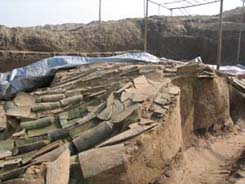
Four well-preserved residences in an ancient village have been
unearthed in central China, providing an insight into rural life
about 2,000 years ago, archaeologists have said.
The village in Neihuang County, Henan Province, belongs to the
late Western Han Dynasty (206 BC - AD25), according to Sun Xinmin,
director of the Henan Provincial Institute of Cultural Relics and
Archaeology.
"With the excavation, archaeologists are able to map out the
layout of the ancient village and the architecture of village
residences in the Western Han Dynasty for the first time," Sun
said.
The unearthed residences are separated by surrounding farmland,
contrary to former guesswork of archaeologists. Sun argued that
this shows the basic social structure in rural areas at that time,
which is one of the most valuable findings.
Every residence has tile roofs, a courtyard and its own well and
consists of a gatehouse, wing-rooms, porches and washrooms.
Archaeologists believe there used to be mulberries, elms, crops
and alleyways outside the courtyards.
The roofs, which are well-preserved in their original state, are
considered extremely precious by archaeologists.
The village is near the ancient Yellow River and was probably
submerged by a flood. After that the village lay silently in the
river course for many years, archaeologists argued.
(Xinhua News Agency February 6, 2006)

